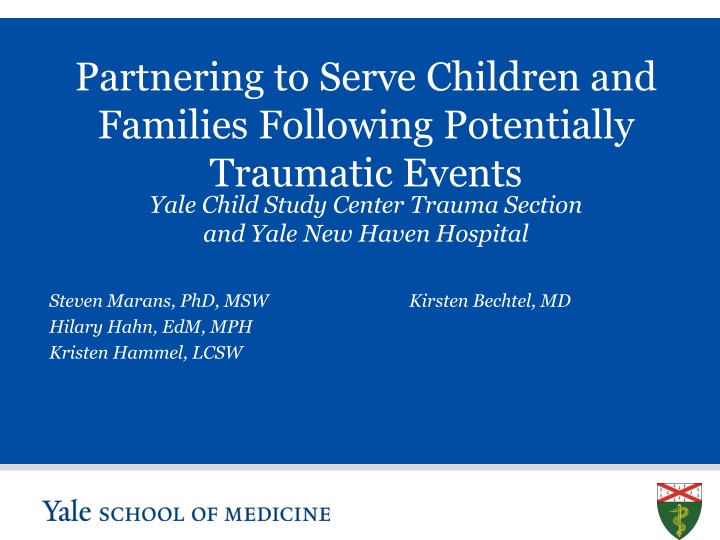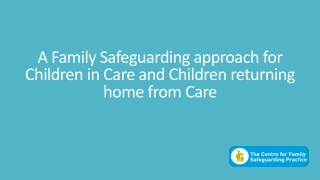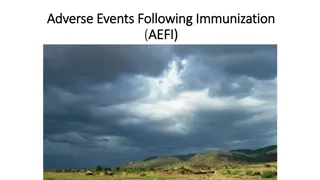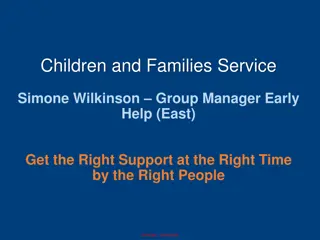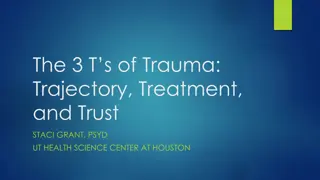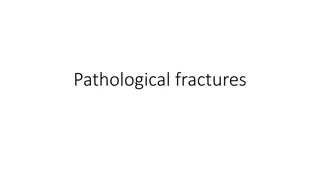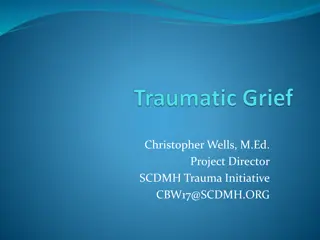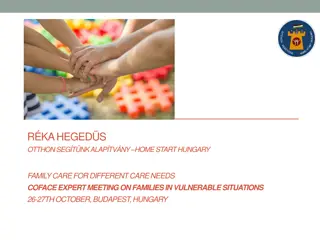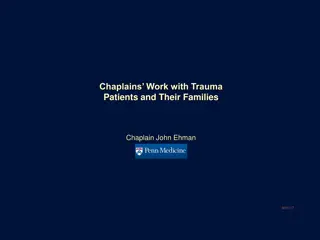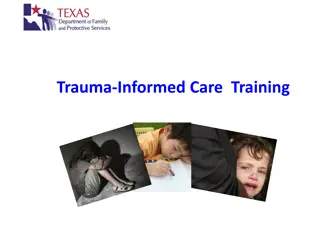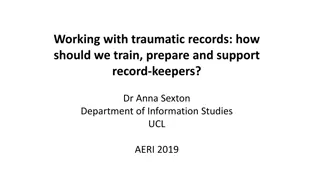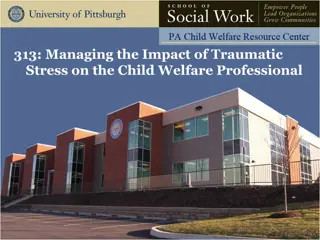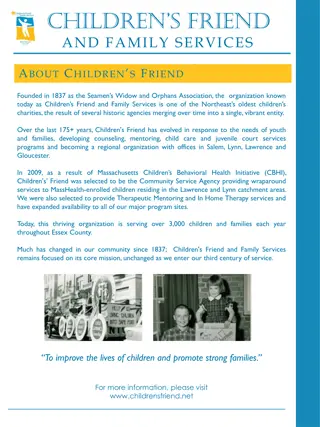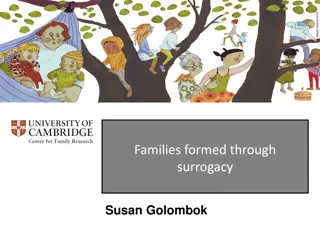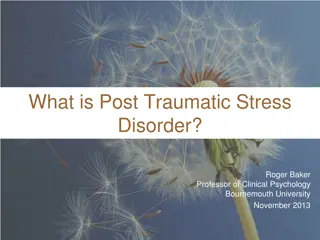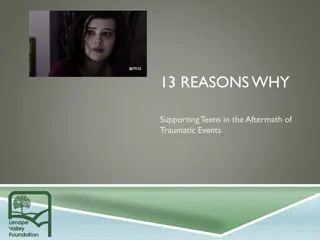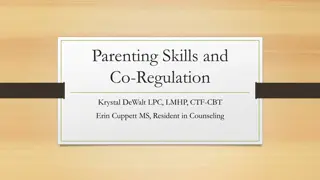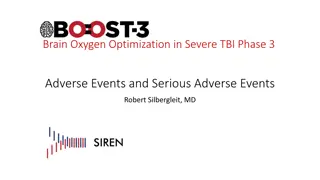Partnering to Serve Children and Families Following Potentially Traumatic Events
Psychological trauma can lead to overwhelming experiences of helplessness, loss of control, and terror, affecting cognitive, emotional, and behavioral responses. Understanding traumatic reactions in children, such as peritraumatic responses, can help in early intervention and treatment to prevent long-term consequences like PTSD and substance abuse.
Download Presentation

Please find below an Image/Link to download the presentation.
The content on the website is provided AS IS for your information and personal use only. It may not be sold, licensed, or shared on other websites without obtaining consent from the author.If you encounter any issues during the download, it is possible that the publisher has removed the file from their server.
You are allowed to download the files provided on this website for personal or commercial use, subject to the condition that they are used lawfully. All files are the property of their respective owners.
The content on the website is provided AS IS for your information and personal use only. It may not be sold, licensed, or shared on other websites without obtaining consent from the author.
E N D
Presentation Transcript
Partnering to Serve Children and Families Following Potentially Traumatic Events Yale Child Study Center Trauma Section and Yale New Haven Hospital Steven Marans, PhD, MSW Hilary Hahn, EdM, MPH Kristen Hammel, LCSW Kirsten Bechtel, MD S L I D E 0
Psychological trauma as injury Overwhelming, unanticipated danger that leads to: Subjective experience of helplessness, loss of control and terror Immobilization of usual methods for decreasing danger and anxiety (fight or flight) Neuro-physiological dysregulation that compromises affective, cognitive and behavioral responses to stimuli S L I D E 1
YCSC Trauma Section A specialty clinic of the Child Study Center Section Chief: Steven Marans, MSW, PhD Acute response and assessment the Child Development Community Policing Program Early intervention and treatment- the Child and Family Traumatic Stress Intervention Longer-term trauma treatment- including Trauma- Focused Cognitive Behavioral Therapy Complex evaluation, differential diagnosis and consultation S L I D E 2
Phases of Traumatic Reactions: A Clinical Roadmap Immediate/acute reactions from within moments to first 24-48 hours Peritraumatic phase symptoms up to 3 months after index event Chronic PTSD and related disorders 3 months after index event Delayed Onset 6 months after index event S L I D E 3
Childrens Peritraumatic Responses to Trauma Blunted emotions Changes in social functioning Social difficulties Dissociation Withdrawal School difficulties/failure Drug and alcohol abuse Sleep disturbances/nightmares Separation anxiety Hyper-vigilance Somatic complaints Irritability and aggression Re-experiencing of event Impulsivity and distractibility Regressive behaviors S L I D E 4
Long-term Consequences Examples of long-term sequelae: Attachment and relationship problems PTSD School failure Suicidal behavior Anxiety disorders Mood disorders Substance abuse Violent/ abusive behaviors Somatic complaints and chronic illness Personality disorders Without recognition, support and treatment early peri- traumatic reactions can persist and result in long-term outcomes Can result in a variety of emotional, behavioral, social and psychiatric consequences S L I D E 5
CFTSI: What Is It? Model developed at the Yale Child Study Center by: Steven Marans, MSW PhD Carrie Epstein, LCSW-R Steve Berkowitz, MD Brief (5-8 session) evidence-based early intervention model for children that is implemented: After recent exposure to a potentially traumatic event After recent disclosure of earlier sexual or physical abuse Serves children ages 3-18 years old, together with their caregivers Based on a family strengthening approach S L I D E 6
Goals of CFTSI CFTSI aims to: Reduce traumatic stress symptoms and prevent chronic PTSD Improve screening and initial assessment of children impacted by traumatic stress Assess child s need for longer-term treatment S L I D E 7
CFTSI RCT Findings 112 study participants recruited from: Forensic Sexual Abuse Program Pediatric Emergency Department New Haven Department of Police Service Animal Bite 5% Sexual Abuse 21% Injury 8% WV/Threats 22% Assault 20% MVA 24% Participants had experienced, on average, >6 trauma types prior to event that precipitated referral for CFTSI and the control treatment in the study S L I D E 8
Major Findings Children who received CFTSI were 65% less likely to meet full criteria for PTSD Children who received CFTSI were 73% less likely to meet partial or full criteria for PTSD Similar results in multiple chart review studies S L I D E 9
CFTSI Outcomes Children Ages 7-17 Receiving CFTSI in Child Advocacy Centers in North and South Carolina S L I D E 10
Change in Child Trauma Symptoms Child (N=161) and Caregiver (N=165) Reported CPSS Scores Pre/Post CFTSI 25 20 15 20.81 10 12.78 5 8.73 6.72 0 Child Pre-CPSS Child Post-CPSS Caregiver Pre-CPSS Caregiver Post-CPSS p < .01 S L I D E 11
Change in Parent-Child Communication Discrepancy in Child and Caregiver Reported CPSS scores Pre/Post CFTSI (N = 161) 25 20 15 10 11.93 5 3.94 0 Discrepancy before CFTSI Discrepancy after CFTSI p < .01 S L I D E 12
Change in Parental Trauma Symptoms Caregiver Reported PCL Scores Pre/Post CFTSI (N=123) 45 40 35 30 25 20 38.33 15 27.42 10 5 0 Caregiver Pre PCL Caregiver Post PCL p < .01 S L I D E 13
Caregiver Survey Results 1. Did you learn about trauma and how it may affect your child and family when you met alone with your CFTSI provider? 2% Yes No 98% S L I D E 14
Caregiver Survey Results 2. Did you learn about how your child s behavior/reactions might be connected to the upsetting experience(s)? 2% Yes No 98% S L I D E 15
Caregiver Survey Results 5. Did you and your child learn about ways/skills to help your child feel better and make the problems and/or reactions your child was having happen less often? Yes 100% S L I D E 16
Caregiver Survey Results 16. If you had a friend dealing with a similar situation, would you suggest that they try CFTSI? 1% Yes Missing 99% S L I D E 17
YCSC and YNNH Collaboration Partnering to identify, educate and refer children and families in the peritraumatic period Children and families seen in the Sexual Abuse Clinic and Emergency Department In the context of both emergency room treatment and forensic evaluations, YNNH colleagues are well-placed to introduce: information about traumatic impact of events referrals for clinical intervention addressing post-traumatic reactions CSC colleagues engage, screen and treat referred children and families and close loop with YNNH colleagues S L I D E 18
Roles in Identifying Cases for Trauma- informed Mental Health Treatment Role of Medical Providers: Identify children who have recently been exposed as victims or witnesses to potentially traumatic events Identify children whose presenting problem may not be trauma (e.g. somatic complaints or psychiatric illness) but an underlying traumatic event is discovered Introduce health and behavioral phenomena associated with traumatic experience and availability of clinical intervention Role of Yale Child Study Center Trauma Section: Screen for trauma symptoms Engage children and families in trauma treatment or connect to other services as appropriate S L I D E 19
